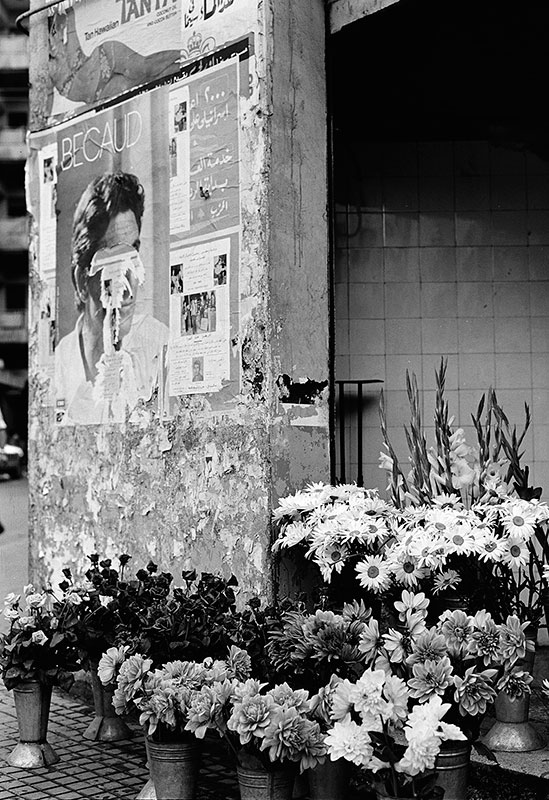The true image of the past flits by. The past can be seized only as an image that flashes up at the moment of its recognizability and is never seen again …For it is an irretrievable image of the past which threatens to disappear in any present that does not recognize itself as intended in that image. – Walter Benjamin, Theses on the Concept of History
Waddah Faris’ photographs had been lying in boxes, collecting dust for nearly half a century. They had largely gone unseen. No seductive narrative can describe the sudden motivation Faris found to return to his archive of negatives and images; he was led to it by unremarkable occurrences. However, he began to find photographs he had never seen before – or ones he could not remember having seen – of moments he often could not remember having experienced.
From the early 1960s up to the outbreak of the Lebanese civil war in 1975, Faris snapped fleeting moments of the everyday. He observed his own extended circle of friends and comrades closely, and took portraits of them caught in action. There were artists mingling at exhibition openings in the Sursock Museum; dancers rehearsing for the Baalbek festival performances; poets and collectors taking long drags of their cigarettes at the Horseshoe Cafe; Annahar journalists speaking on the phone in their offices; large gatherings of friends eating and drinking at the Palmyra Hotel in the Bekaa valley; Stockhausen in the grottos of Jeita; Max Ernst at the Basta market– the list goes on. Faris developed some of the film, but eventually stowed the photographs away, leaving them dispersed in the places he moved between. They would have likely gone unseen; they would have not even flitted by.
Waddah Faris is not a photographer per se. As an opposer to the professionalization of the sphere of art, he at times dabbled, and at others, plunged in an impressive range of activities. For the most part, he produced the graphic designs for books and journals, including the cover of Ghassan Kanafani’s first book موت سرير رقم ١٢ (A death in Bed No. 12). He had short stints at both Annahar and al-Hurriya newspapers as a graphic designer, and regularly contributed drawings and designs to the reviews Shi’r and Hiwar. With César Nammour and Mireille Tabet as his partners, he founded Contact in 1972– an art gallery in Ras Beirut which hosted an erratic program of young, modern Arab artists at a time when commercial art galleries were preoccupied with European art. The gallery ran three zany issues of a review also titled Contact. Rather than a catalogue of objects for sale, it was intended as a directory of exhibitions and events happening elsewhere in the city, as well as a literary journal which published poetry, prose, and articles of criticism – often astringent – of the gallery’s own
exhibitions. In 1974, Faris alone began to set up Al Riwaq, an art gallery which failed to open to the public under the perilous conditions of the impending war. With the civil war erupting, Faris moved to Paris where he founded and ran The Faris Gallery (1979-1992). It was the third of his art galleries, and the most conventional. Faris continued to represent Arab artists, but he was now participating periodically in art fairs like the FIAC and Art Basel. Eventually, he came to settle in Barcelona.
In all of this, Faris’ photographic practice was peripheral. Whether he took pictures for posterity is impertinent, for the pictures retroactively gain an urgency which exceeds his intentions.
The photographs seize the past in the form of an image, but this past is not a determinate object: it is not a fixed set of spatial or temporal coordinates, nor is it an archive from which historical material can be appropriated. What is known of the past does not exist apart from the present’s relation to it. The past itself is subject to historical change. The two are dialectically intertwined. The past is a disruptive force actualized in the present – the former only comes into being when resurrected as the latter. To historicize the sixties as the era of failed struggles puts the past in the service of the needs of the present. However, the past cannot be assimilated within a definitive course of history. The past calls into question the necessity of the historical outcome in the present. Unlike the historicist’s descriptive account, Faris’ images have an actualizing agency.
They are not to be contemplated. To intervene in the unfulfilled past of each present, the images are to be acted upon. An exhibition such as this one should not be misunderstood as an attempt to represent the past ‘as it really happened’. Rather, it is a venture into an unfulfilled past. To quote Walter Benjamin’s Theses on the Concept of History once more, “If one looks upon history as a text, then one can say of it…that the past has left in them images comparable to those registered by a light-sensitive plate.” The light-sensitive plate is the negative – the undeveloped film. It registers the images of the past, but it is not readable or cognizable. It is no mishap that Faris had never developed, printed, scanned and displayed his photographs. The historical distance was a necessary one. Now printed and on display, the images are here to be read. And yet, it is in a potential future which we can aspire to descry the details.























